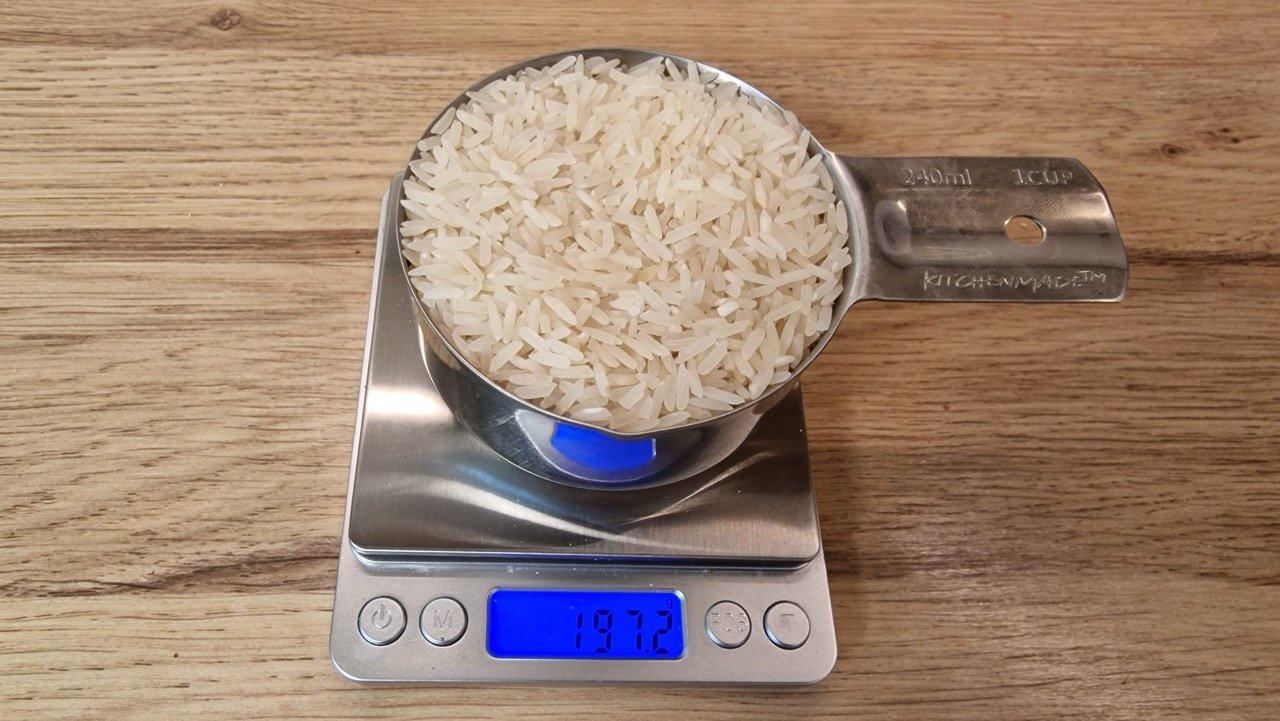Measuring ingredients with accuracy is crucial in culinary practices, especially when dealing with staples like Jasmine rice. Known for its fragrant aroma and slightly sticky texture when cooked, Jasmine rice is a key ingredient in many Asian dishes. Proper measurement is essential to achieve the desired consistency and flavor profile, whether the rice is being used as a side dish or as the base for a more complex recipe.
This article will explore the various ways to measure Jasmine rice using units such as cups, grams, ounces, and tablespoons, aiming to assist in maintaining consistency and achieving flawless results in your cooking.
Understanding Jasmine Rice Measurements
Overview of Common Measurement Units
- Cups: Commonly used for measuring rice in volume, particularly in home kitchens.
- Grams: Provides more accuracy and is preferred in recipes that require precise water-to-rice ratios.
- Ounces: Used less frequently for rice but can be important in certain dietary recipes.
- Tablespoons: Helpful for adjusting smaller quantities or when cooking for one.
Why Jasmine Rice Measurements Can Be Tricky
The main challenge in measuring Jasmine rice stems from its volume expansion after cooking, which can affect the final serving size. Additionally, factors such as the age of the rice and its moisture content before cooking can influence how much water it absorbs, thereby affecting its texture and fluffiness.
Practical Measurement Tips
How to Measure Jasmine Rice Accurately
- Using Kitchen Scales: For recipes that demand precision, measuring Jasmine rice by weight (grams or ounces) ensures accuracy. This method is particularly useful in balancing the rice-to-water ratio perfectly.
- Proper Way to Fill a Measuring Cup: When measuring rice by volume, scoop the Jasmine rice into the measuring cup and level it off with a straight edge to avoid compressing it, which could lead to using more rice than needed for the desired texture.
Adjusting Recipes
Adjustments in the measurement of Jasmine rice may be necessary depending on the desired outcome of the dish. For fluffier rice, a slight decrease in water or rice might be needed if the initial batch is too sticky. Conversely, a bit more water can help if the rice is too dry or hard after cooking. Mastery over these adjustments can help perfect the cooking of Jasmine rice according to individual tastes and specific recipes.
Nutritional Benefits of Jasmine Rice
Jasmine rice not only offers a delightful fragrance and taste but also provides several nutritional benefits:
- Carbohydrates: Jasmine rice is a good source of energy-providing carbohydrates.
- Low in Fat and Fiber: It has minimal fat and a low fiber content, making it easy to digest.
- Vitamins and Minerals: Contains folic acid, iron, and other B vitamins, though in smaller quantities compared to whole grains.
- Protein: Provides a modest amount of protein, essential for body repair and growth.
Jasmine Rice Conversion Tables And Formulas
Jasmine rice is also called Thai Jasmine rice, Thai fragrant rice, Hom Mali, Khao Hom Mali. All names refer to the same ingredient, so conversion rates shown below are valid for each of these.
Most Common Conversions for Jasmine Rice
- 1 teaspoon of jasmine rice: 4 grams.
- 1 tablespoon of jasmine rice: 12 grams.
- 1 US cup of jasmine rice: 197 grams.
- 1 UK cup of jasmine rice: 205 grams.
Jasmine Rice US Cups to Grams and Ounces
| US Cups of jasmine rice (Thai Jasmine rice, Thai fragrant rice, Hom Mali, Khao Hom Mali) | Amount in grams (g) | Amount in ounces (oz) |
|---|---|---|
| 1/8 cup | 25 g | 0.87 oz |
| 1/4 cup | 49 g | 1.74 oz |
| 1/3 cup | 66 g | 2.31 oz |
| 3/8 cup | 74 g | 2.6 oz |
| 1/2 cup | 98 g | 3.47 oz |
| 5/8 cup | 123 g | 4.34 oz |
| 2/3 cup | 131 g | 4.63 oz |
| 3/4 cup | 148 g | 5.21 oz |
| 7/8 cup | 172 g | 6.08 oz |
| 1 cup | 197 g | 6.94 oz |
| 2 cups | 394 g | 13.89 oz |
| 3 cups | 591 g | 20.83 oz |
| 4 cups | 787 g | 27.78 oz |
| 5 cups | 984 g | 34.72 oz |
| 6 cups | 1181 g | 41.66 oz |
| 7 cups | 1378 g | 48.61 oz |
| 8 cups | 1575 g | 55.55 oz |
| 9 cups | 1772 g | 62.5 oz |
| 10 cups | 1969 g | 69.44 oz |
Jasmine Rice UK Cups to Grams and Ounces
| UK Cups of jasmine rice (Thai Jasmine rice, Thai fragrant rice, Hom Mali, Khao Hom Mali) | Amount in grams (g) | Amount in ounces (oz) |
|---|---|---|
| 1/8 cup | 26 g | 0.9 oz |
| 1/4 cup | 51 g | 1.81 oz |
| 1/3 cup | 68 g | 2.41 oz |
| 3/8 cup | 77 g | 2.71 oz |
| 1/2 cup | 103 g | 3.62 oz |
| 5/8 cup | 128 g | 4.52 oz |
| 2/3 cup | 137 g | 4.82 oz |
| 3/4 cup | 154 g | 5.43 oz |
| 7/8 cup | 179 g | 6.33 oz |
| 1 cup | 205 g | 7.23 oz |
| 2 cups | 410 g | 14.47 oz |
| 3 cups | 615 g | 21.7 oz |
| 4 cups | 820 g | 28.93 oz |
| 5 cups | 1025 g | 36.17 oz |
| 6 cups | 1230 g | 43.4 oz |
| 7 cups | 1435 g | 50.63 oz |
| 8 cups | 1641 g | 57.87 oz |
| 9 cups | 1846 g | 65.1 oz |
| 10 cups | 2051 g | 72.33 oz |
Jasmine Rice Tablespoons to Grams and Ounces
There is now real practical use in measuring jasmine rice with a tablespoon. However, for complete conversion rates we give you the theoretical tablespoon measurements in grams.
| Tbsp of jasmine rice (Thai Jasmine rice, Thai fragrant rice, Hom Mali, Khao Hom Mali) | Amount in grams (g) | Amount in ounces (oz) |
|---|---|---|
| 1/4 tbsp | 3 g | 0.11 oz |
| 1/3 tbsp | 4 g | 0.14 oz |
| 1/2 tbsp | 6 g | 0.22 oz |
| 1 tbsp | 12 g | 0.43 oz |
| 2 tbsp | 25 g | 0.87 oz |
| 3 tbsp | 37 g | 1.3 oz |
| 4 tbsp | 49 g | 1.74 oz |
| 5 tbsp | 62 g | 2.17 oz |
| 6 tbsp | 74 g | 2.6 oz |
| 7 tbsp | 86 g | 3.04 oz |
| 8 tbsp | 98 g | 3.47 oz |
| 9 tbsp | 111 g | 3.91 oz |
| 10 tbsp | 123 g | 4.34 oz |
Jasmine Rice Teaspoons to Grams and Ounces
There is now real practical use in measuring jasmine rice with a teaspoon. However, for complete conversion rates we give you the theoretical teaspoon measurements in grams.
| Tsp of jasmine rice (Thai Jasmine rice, Thai fragrant rice, Hom Mali, Khao Hom Mali) | Amount in grams (g) | Amount in ounces (oz) |
|---|---|---|
| 1 tsp | 4 g | 0.14 oz |
| 2 tsp | 8 g | 0.29 oz |
| 3 tsp | 12 g | 0.43 oz |
| 4 tsp | 16 g | 0.58 oz |
| 5 tsp | 21 g | 0.72 oz |
| 6 tsp | 25 g | 0.87 oz |
| 7 tsp | 29 g | 1.01 oz |
| 8 tsp | 33 g | 1.16 oz |
| 9 tsp | 37 g | 1.3 oz |
| 10 tsp | 41 g | 1.45 oz |
Metric vs. Imperial Conversions
When working with jasmine rice in the kitchen, it's essential to be adept at converting between the metric and imperial systems of measurement. This skill ensures accuracy in following recipes from different culinary traditions around the world.
The metric system, commonly used around the world, measures jasmine rice primarily in grams and kilograms. This system is favored for its simplicity and ease of scaling.
Predominantly used in the United States, the imperial system measures jasmine rice in tablespoons and teaspoons. While not as straightforward as scaling, it is deeply integrated into many traditional American recipes.
Common Measurement Units for Jasmine Rice
Jasmine rice can be measured by either volume or weight. Ingredients that come in large pieces, such as jasmine rice, are the worst to be measured by volume (e.g. cups). Cups measurement for jasmine rice are very unreliable, different measurements can differ by even more than 20%. Use a kitchen scale instead for precise measurement.
Most typical volume measurements for jasmine rice are:
- Teaspoons (tsp)
- Tablespoons (tbsp)
- Cups
Most typical weight measurements for jasmine rice are:
- Ounces (oz)
- Grams (g)
- Kilograms (kg)
- Pounds (lbs)
How We Measure Jasmine Rice?
To make sure that our conversion rates are correct, we don't just copy data from other websites. We actually take at least 5 different measurements of 1 cup of jasmine rice and use the average for calculations and conversion tables. Read more on our measurement methodology by clicking on this link.

